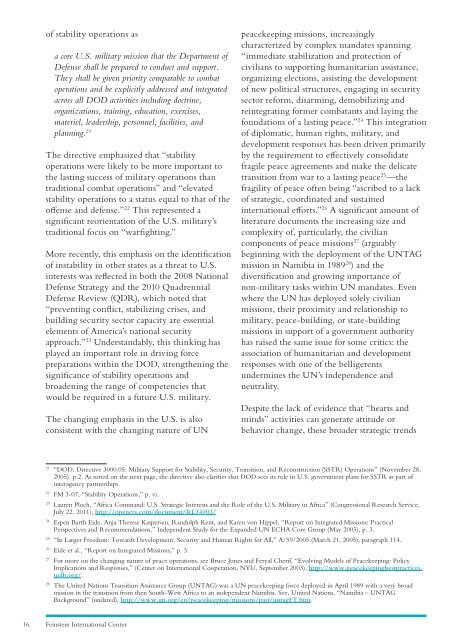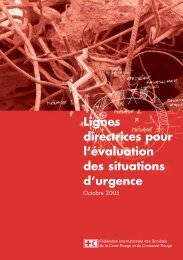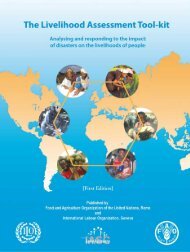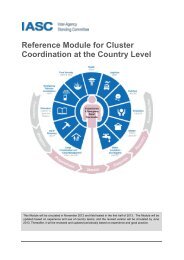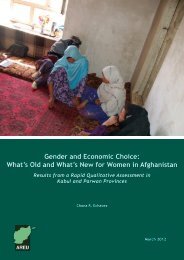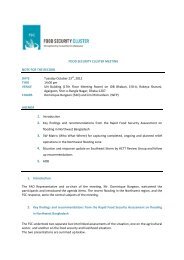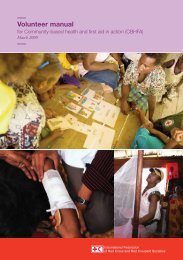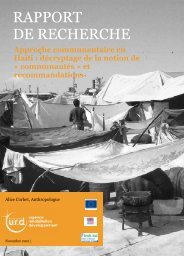Winning Hearts and Minds? - Tufts - Tufts University
Winning Hearts and Minds? - Tufts - Tufts University
Winning Hearts and Minds? - Tufts - Tufts University
Create successful ePaper yourself
Turn your PDF publications into a flip-book with our unique Google optimized e-Paper software.
of stability operations asa core U.S. military mission that the Department ofDefense shall be prepared to conduct <strong>and</strong> support.They shall be given priority comparable to combatoperations <strong>and</strong> be explicitly addressed <strong>and</strong> integratedacross all DOD activities including doctrine,organizations, training, education, exercises,materiel, leadership, personnel, facilities, <strong>and</strong>planning. 21The directive emphasized that “stabilityoperations were likely to be more important tothe lasting success of military operations thantraditional combat operations” <strong>and</strong> “elevatedstability operations to a status equal to that of theoffense <strong>and</strong> defense.” 22 This represented asignificant reorientation of the U.S. military’straditional focus on “warfighting.”More recently, this emphasis on the identificationof instability in other states as a threat to U.S.interests was reflected in both the 2008 NationalDefense Strategy <strong>and</strong> the 2010 QuadrennialDefense Review (QDR), which noted that“preventing conflict, stabilizing crises, <strong>and</strong>building security sector capacity are essentialelements of America’s national securityapproach.” 23 Underst<strong>and</strong>ably, this thinking hasplayed an important role in driving forcepreparations within the DOD, strengthening thesignificance of stability operations <strong>and</strong>broadening the range of competencies thatwould be required in a future U.S. military.The changing emphasis in the U.S. is alsoconsistent with the changing nature of UNpeacekeeping missions, increasinglycharacterized by complex m<strong>and</strong>ates spanning“immediate stabilization <strong>and</strong> protection ofcivilians to supporting humanitarian assistance,organizing elections, assisting the developmentof new political structures, engaging in securitysector reform, disarming, demobilizing <strong>and</strong>reintegrating former combatants <strong>and</strong> laying thefoundations of a lasting peace.” 24 This integrationof diplomatic, human rights, military, <strong>and</strong>development responses has been driven primarilyby the requirement to effectively consolidatefragile peace agreements <strong>and</strong> make the delicatetransition from war to a lasting peace 25 —thefragility of peace often being “ascribed to a lackof strategic, coordinated <strong>and</strong> sustainedinternational efforts.” 26 A significant amount ofliterature documents the increasing size <strong>and</strong>complexity of, particularly, the civiliancomponents of peace missions 27 (arguablybeginning with the deployment of the UNTAGmission in Namibia in 1989 28 ) <strong>and</strong> thediversification <strong>and</strong> growing importance ofnon-military tasks within UN m<strong>and</strong>ates. Evenwhere the UN has deployed solely civilianmissions, their proximity <strong>and</strong> relationship tomilitary, peace-building, or state-buildingmissions in support of a government authorityhas raised the same issue for some critics: theassociation of humanitarian <strong>and</strong> developmentresponses with one of the belligerentsundermines the UN’s independence <strong>and</strong>neutrality.Despite the lack of evidence that “hearts <strong>and</strong>minds” activities can generate attitude orbehavior change, these broader strategic trends21“DOD, Directive 3000.05: Military Support for Stability, Security, Transition, <strong>and</strong> Reconstruction (SSTR) Operations” (November 28,2005). p.2. As noted on the next page, the directive also clarifies that DOD sees its role in U.S. government plans for SSTR as part ofinteragency partnerships.22FM 3-07, “Stability Operations,” p. vi.23Lauren Ploch, “Africa Comm<strong>and</strong>: U.S. Strategic Interests <strong>and</strong> the Role of the U.S. Military in Africa” (Congressional Research Service,July 22, 2011), http://opencrs.com/document/RL34003/24Espen Barth Eide, Anja Therese Kaspersen, R<strong>and</strong>olph Kent, <strong>and</strong> Karen von Hippel, “Report on Integrated Missions: PracticalPerspectives <strong>and</strong> Recommendations,” Independent Study for the Exp<strong>and</strong>ed UN ECHA Core Group (May 2005), p. 3.25“In Larger Freedom: Towards Development, Security <strong>and</strong> Human Rights for All,” A/59/2005 (March 21, 2005), paragraph 114.26Eide et al., “Report on Integrated Missions,” p. 3.27For more on the changing nature of peace operations, see Bruce Jones <strong>and</strong> Feryal Cherif, “Evolving Models of Peacekeeping: PolicyImplications <strong>and</strong> Responses,” (Center on International Cooperation, NYU, September 2003), http://www.peacekeepingbestpractices.unlb.org/.28The United Nations Transition Assistance Group (UNTAG) was a UN peacekeeping force deployed in April 1989 with a very broadmission in the transition from then South-West Africa to an independent Namibia. See, United Nations, “Namibia – UNTAGBackground” (undated), http://www.un.org/en/peacekeeping/missions/past/untagFT.htm.16Feinstein International Center


